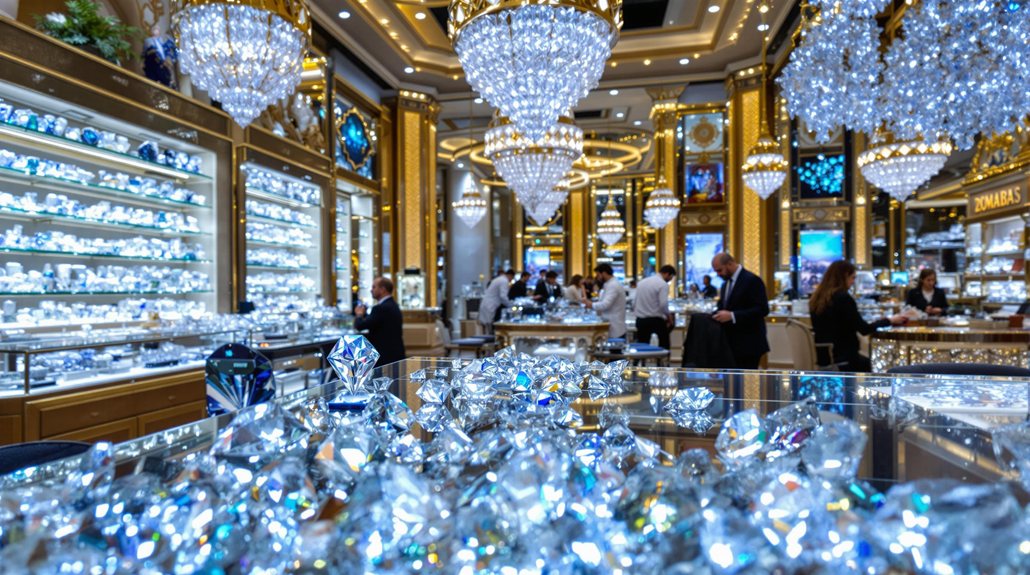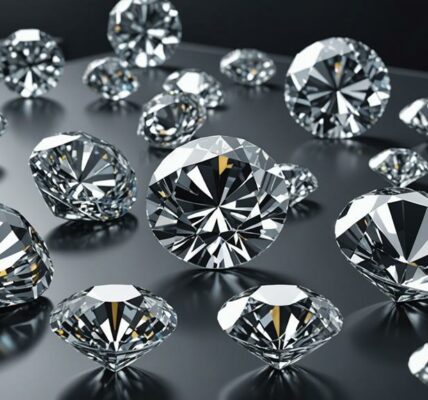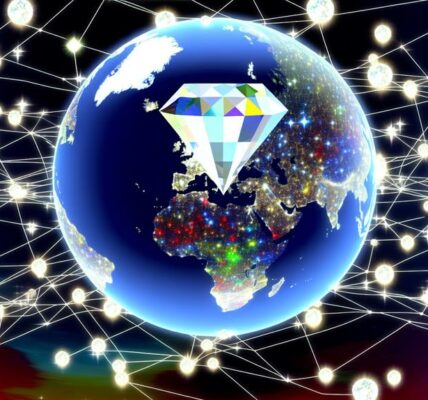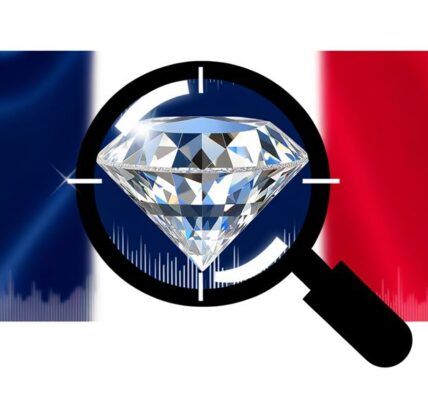Dubai’s Diamond Trade Reports Record-Breaking Diamond Trade Volumes, Lab-grown Sector Surged 51% in ’24
In 2024, Dubai’s diamond trade reached new heights with remarkable growth. The total trade value soared to $38.3 billion, with the polished diamond segment increasing by 32% over the previous year. A standout development was the lab-grown diamond sector, which experienced an extraordinary 51% surge, reaching 15.9 million carats.
This surge is driven by increasing consumer interest in affordable and ethically sourced diamonds, enhanced by technological advancements that guarantee quality. Dubai’s strategic position and business-friendly environment have made it a global leader in this industry. Discover the fascinating drivers behind these record-breaking trade volumes and future market prospects.
Article Contents
- 1 Main Highlights
- 2 Record Diamond Trade Volumes
- 3 Economic Impact of Diamond Trade
- 4 Lab-Grown Diamond Market Growth
- 5 Key Market Drivers
- 6 Trade and Investment Opportunities
- 7 Future Market Projections
- 8 Frequently Asked Questions
- 8.1 What Are the Key Differences Between Natural and Lab-Grown Diamonds?
- 8.2 How Does the UAE’s Diamond Trade Impact the Local Job Market?
- 8.3 What Are the Environmental Benefits of Lab-Grown Diamonds?
- 8.4 Are There Any Cultural Factors Influencing Diamond Demand in the UAE?
- 8.5 How Does Dubai’s Diamond Trade Compare to Other Luxury Goods Markets?
- 9 Our Concluding Thoughts
Main Highlights
- In 2023, Dubai’s diamond trade reached a total value of $38.3 billion, with significant growth in the polished diamond sector.
- The lab-grown diamond trade in Dubai surged by 51% in the first half of 2024, totalling 15.9 million carats.
- Dubai has overtaken Belgium as the largest hub for rough diamond trading, with trade valued at $37.4 billion in 2022.
- The lab-grown diamond market is projected to grow from USD 22.79 billion in 2023 to USD 74.45 billion by 2032.
- Technological advancements in synthesis and monitoring systems are enhancing lab-grown diamond production and trade in Dubai.
Record Diamond Trade Volumes
Dubai’s diamond trade has reached unprecedented levels, with 2023 witnessing a total trade value of $38.3 billion. This remarkable figure is shaped by intriguing diamond pricing trends and an extensive market segmentation analysis.
The polished diamond segment significantly surged by 32% year-on-year, reaching an impressive $16.9 billion. This growth signifies a strategic shift in market focus, underscoring the increasing value and demand for polished diamonds within the global trade landscape. Conversely, the rough diamond trade witnessed a 13% decrease, totalling $21.3 billion, reflecting a global price drop of 20% in 2023.
When dissecting market segmentation, it’s evident that polished diamonds now account for 44% of the total trade value, highlighting a substantial shift in Dubai’s diamond market dynamics. The compound annual growth rate over five years stands at 11%, showcasing Dubai’s resilient expansion in the diamond sector. Dubai accounted for 44% of total UAE diamond trade value, further solidifying its role as a pivotal hub in the global diamond market.
In the initial half of 2024, the volume of diamonds traded rose by 12% to 119.4 million carats, with a significant surge in the lab-grown diamond sector, increasing by 51% to 15.9 million carats. Dubai’s DMCC continues to play a crucial role in promoting the precious stones sector, further cementing Dubai’s status as a leader in the diamond trade. This diversification illuminates Dubai’s adaptability and foresight in catering to evolving market demands, ensuring sustained growth in its diamond trade.
Economic Impact of Diamond Trade
The diamond trade exerts a profound economic impact globally and locally, contributing an annual net economic benefit of $16 billion. This industry supports livelihoods worldwide, employing 77,000 directly in mining and millions more across the supply chain. For every mining job, numerous others are created, spurring growth in logistics, manufacturing, and retail sectors.
Artisanal mining, particularly in Africa, plays a significant role in uplifting communities and fostering economic independence. The growing trade relationship between Israel and the UAE, highlighted by the diamond trade valued at $1.75 billion in 2022, reflects the strengthening economic ties post-Abraham Accords. Notably, modern mining companies adhere to strict environmental and social standards, focusing on sustainable practices that enhance community welfare and environmental stewardship.
The table below illustrates key economic contributions:
| Region | Employment Impact | Economic Contribution |
|---|---|---|
| Global | 77,000 mining jobs | $16 billion net benefits |
| India (Gujarat) | 1 million in cutting/polishing | Funds schools, hospitals |
| Africa | Supports ASM communities | Promotes gender equality |
| UAE (Dubai) | Enhances Israeli business ties | 7% of emirate’s GDP |
| Namibia/Botswana | Gender empowerment | Community development |
In India, the diamond sector funds essential infrastructure, while in the UAE, the trade surged by 12% in 2024, enhancing global business connections. By eliminating tariffs through partnerships like the UAE-Israel agreement, the industry fosters economic diversification and development, strengthening its role as a cornerstone of economic prosperity.
Lab-Grown Diamond Market Growth
The lab-grown diamond market is experiencing significant growth, driven by a surge in consumer demand and technological advancements. Consumers are increasingly drawn to lab-grown diamonds due to their affordability, sustainability, and ethical advantages over natural diamonds. Furthermore, innovations in manufacturing techniques, such as HPHT and CVD, have improved the quality and availability of these diamonds, contributing to their rising popularity in global markets. Asia Pacific emerged as the largest global lab-grown diamonds market, further fuelling industry expansion. The market is projected to grow at a Compound Annual Growth Rate (CAGR) of 14. 11% during the forecast period, reflecting the increasing acceptance and adoption of lab-grown diamonds worldwide. This growth is further driven by the increasing disposable income and changing preferences of consumers in Asia Pacific. Moreover, the region’s thriving jewelry industry and growing awareness about environmental sustainability and ethical sourcing are contributing to the rising demand for lab-grown diamonds in Asia Pacific. As a result, industry players are focusing on expanding their presence and operations in the region to capitalize on the lucrative opportunities offered by the Asia Pacific market.
Consumer Demand Surge
Surging consumer demand is a pivotal driver behind the remarkable growth of the lab-grown diamond market. This demand is largely fuelled by shifts towards ethical purchasing and sustainability trends, reflecting a broader change in consumer values. As individuals seek alternatives to traditional diamonds, lab-grown options offer a compelling combination of ethical sourcing, affordability, and ecological responsibility. The lab-grown diamond market has been identified as the fastest-growing segment in the jewellery market. The increasing appeal of lab-grown diamonds can be attributed to several factors:
- Global Retail Sales: Retail sales of lab-grown diamonds skyrocketed to $12.24 billion in 2022, highlighting their growing popularity among consumers.
- Export Growth: Exports of lab-grown diamonds saw a significant increase, tripling during the fiscal year 2021-2022, indicating rising acceptance and demand worldwide.
- Dubai’s Market Expansion: Dubai’s lab-grown diamond trade surged by 51% in the initial half of 2024, reaching 15.9 million carats, demonstrating robust regional market growth.
These trends underscore a shift in consumer priorities, where sustainability concerns and ethical choices are paramount. The Asia Pacific region, with its dominance in market share, and countries like China, with substantial production capacity, are poised to meet this surging demand. The global CVD lab-grown diamonds market is projected to grow from $11.72 billion in 2023 to $12.92 billion in 2024, indicating an expanding consumer base and increased production capabilities. As the market expands, consumers continue to adopt the freedom of choice that lab-grown diamonds represent.
Technological Advancements Impact
Technological advancements are considerably shaping the lab-grown diamond market, driving growth through improved manufacturing and customisation capabilities. Key developments in synthesis techniques, such as High-Pressure High Temperature (HPHT) and Chemical Vapour Deposition (CVD) methods, have improved the quality and speed of diamond production. These methods, combined with advanced modelling tools like computational fluid dynamics and finite element analysis, guarantee uniformity and efficiency in diamond growth.
Monitoring systems further refine precision, making the production process more consistent and reliable. In laboratory settings, controlled environments ensure precision in diamond synthesis, which enhances the overall quality of lab-grown diamonds. Lab-grown diamonds are marketed as environmentally friendly alternatives, requiring significantly fewer resources compared to mined diamonds, and have a smaller environmental footprint. Customisation trends are also transforming the market. Consumers now enjoy the freedom to tailor diamonds to their unique preferences.
Advanced materials research allows for diamonds with distinct qualities, like increased brightness or durability, expanding consumer choices and pushing market growth. Blockchain technology plays a significant role in offering transparency, assuring consumers can trace the origin and attributes of their diamonds, thereby fostering trust and ethical sourcing. These technological innovations not only bolster the current market, valued at USD 22.79 billion in 2023, but they also support projections of reaching USD 74.45 billion by 2032. As consumer interest grows, the lab-grown diamond sector continues to thrive, driven by these technological advancements.
Key Market Drivers
Amidst a rapidly evolving global landscape, several key market drivers underpin the burgeoning diamond trade in Dubai. The emirate’s diamond industry is set apart by a robust supply chain and a commitment to sustainability practices, aligning with shifting consumer preferences for ethically sourced gems. This dedication not only satisfies demand for traceability but also improves Dubai’s standing as a leading trade hub.
Key market drivers include:
- Volume and Variety: A remarkable 12% increase in natural diamond trade volumes, alongside a 51% surge in lab-grown diamond transactions, highlights the diverse offerings that cater to both traditional and modern markets. Dubai has surpassed Belgium as the largest rough diamond trading hub, reinforcing its position as a key player in the diamond industry.
- Strategic Location and Infrastructure: Dubai’s geographic advantage, coupled with state-of-the-art infrastructure, facilitates seamless global connectivity, attracting international traders seeking efficiency and accessibility. Its strategic location between Africa and India enhances its role as a pivotal point in the diamond supply chain, providing direct access to major diamond sources and processing centres.
- Innovative Solutions: Technological advancements, including blockchain and AI, strengthen transparency and traceability, ensuring ethical compliance and increasing consumer confidence.
Despite challenges like global price downturns and weak demand, Dubai’s proactive acceptance of change and innovation positions it as a resilient leader in the diamond trade.
The emirate’s focus on sustainable growth strategies not only addresses current market demands but also paves the way for future success.
Trade and Investment Opportunities

The Dubai Multi Commodities Centre (DMCC) has significantly bolstered the city’s diamond trade, creating a thriving ecosystem that attracts global investors and traders. By fostering expanding global partnerships, Dubai has positioned itself as a crucial player in the diamond industry, enhancing trade flows and investment opportunities. This strategic collaboration not only amplifies Dubai’s economic impact but also solidifies its reputation as a premier hub for diamond commerce worldwide.
The business-friendly regulatory environment in Dubai simplifies company setup processes and offers tax benefits, which further contributes to the city’s appeal as a global diamond trading hub. The high liquidity of diamond investments allows investors to quickly access cash, providing an immediate exit option and enhancing the attractiveness of the market.
DMCC’s Economic Impact
Positioned as a leading force in Dubai’s economic landscape, the Dubai Multi Commodities Centre (DMCC) significantly impacts trade volumes and investment opportunities within the diamond sector.
The DMCC’s influence is rooted in its strategic advantages, particularly its regulatory environment and foreign ownership policies. These elements make it an attractive hub for global diamond traders, offering 100% foreign ownership, zero import and export duties, and no personal or corporate income taxes. Dubai’s strategic location at the crossroads of East and West further enhances the DMCC’s position, providing unparalleled access to major global markets. In addition, the economic output of Dubai, driven in part by the DMCC, reached US$4.98 billion in 2023, showcasing a robust growth trajectory.
The DMCC’s contributions to Dubai’s economy are substantial. Remarkably, the district accounted for 15% of Dubai’s foreign direct investment (FDI) in the primary half of 2024, marking an increase from 11% in the previous year.
This growth reflects the DMCC’s pivotal role in driving economic expansion and diversification. The district’s dynamic business environment is further highlighted by the inclusion of 1,023 new member companies within the same period, underscoring its appeal to international investors.
Key Highlights:
- Regulatory Advantages: Business-friendly regulations and incentives attract global traders.
- Foreign Ownership: 100% foreign ownership bolsters international investment.
- Economic Contributions: Significant FDI and GDP contributions illustrate DMCC’s impact.
Thus, the DMCC continues to empower investors seeking freedom and growth in the diamond trade.
Expanding Global Partnerships
Frequently, the Dubai Multi Commodities Centre (DMCC) demonstrates its commitment to expanding global partnerships by actively engaging with key international players in the diamond industry. A recent high-level visit to the Bharat Diamond Bourse (BDB) exemplifies this effort, fostering deeper collaboration and mutual growth. This partnership aligns with sustainable practices and ethical sourcing, crucial elements for the future of the diamond trade.
The DMCC and BDB are poised to investigate new possibilities, driven by the Comprehensive Economic Partnership Agreement (CEPA) between India and the UAE, which opens doors for groundbreaking collaborations. During the visit, discussions also addressed the challenges faced by traders in opening new accounts in Dubai, highlighting the need for banking reforms to facilitate smoother operations. With Dubai’s diamond trade valued at US$37.4 billion in 2022, the city is positioning itself as a leading diamond trade hub.
The following table highlights key opportunities and benefits:
| Opportunity | Benefit | Strategic Focus |
|---|---|---|
| Strengthening India Ties | Improved collaboration and growth | Sustainable practices |
| CEPA Agreement | New trade and investment avenues | Ethical sourcing |
| Dubai’s Strategic Location | Hub for global diamond trade | Global partnerships |
Dubai’s strategic location and business-friendly environment enhance its appeal as a hub for the diamond industry. The vibrant ecosystem supports investment in diverse areas, from mining to retail. This synergy elevates trade volumes and reinforces Dubai’s role as a global leader, ensuring that sustainable and ethical practices remain at the forefront of industry development.
Future Market Projections
As the diamond industry looks towards the future, projections indicate a robust growth trajectory, with the global market anticipated to expand from USD 41.49 billion in 2024 to USD 50.23 billion by 2030.
This growth is poised to be driven by several factors, including evolving market challenges and a dynamic competitive landscape. The market will see:
- Supply and Demand Shifts: The constrained supply of natural diamonds, declining at approximately 1% CAGR, juxtaposed with a rising demand of 2% to 4% CAGR, presents opportunities for both natural and lab-grown diamond sectors to thrive. Notably, the global diamond market was valued at USD 96.4 billion in 2022, indicating the substantial size and importance of the industry.
- Technological Advancements: The lab-grown diamond sector, particularly in Dubai, is experiencing significant growth due to state-of-the-art infrastructure and specialised facilities, contributing to a 51% surge in trade volumes in 2024. The DMCC’s strategic infrastructure and focus on innovation have made Dubai a key player in the LGD trade and innovation landscape.
- Regional Dynamics: Asia Pacific, driven by strong demand from millennials, is set to play a pivotal role in market expansion, while Dubai’s emergence as a global hub under favourable tax policies will fortify its position in the diamond trade.
In manoeuvring through these market challenges, industry players must remain agile, adjusting strategies to harness opportunities in this evolving competitive landscape.
Frequently Asked Questions
What Are the Key Differences Between Natural and Lab-Grown Diamonds?
Natural diamonds possess unique characteristics formed over billions of years, whilst lab-grown diamonds are created rapidly through controlled processes. Both share similar physical properties, but their origins and formation methods greatly distinguish them regarding authenticity and value.
How Does the UAE’s Diamond Trade Impact the Local Job Market?
The UAE’s diamond trade, a rising tide lifting all boats, greatly influences job creation and market dynamics. With 750-1000 new positions, primarily in high-earning sectors, it bolsters economic growth and provides diverse opportunities for local talent.
What Are the Environmental Benefits of Lab-Grown Diamonds?
Lab-grown diamonds offer significant environmental benefits, including a reduced carbon footprint and ethical sourcing. Their production lowers water consumption, minimises ecosystem impact, and employs energy-efficient processes, liberating consumers from the environmental concerns associated with mined diamonds.
Are There Any Cultural Factors Influencing Diamond Demand in the UAE?
In the UAE, diamond demand sparkles as a tapestry woven with cultural significance and gifting traditions. Diverse demographics adopt diamonds for engagements and anniversaries, reflecting a fusion of heritage and modernity that captivates those seeking unique expressions of love.
How Does Dubai’s Diamond Trade Compare to Other Luxury Goods Markets?
Dubai’s diamond trade, a key player within the luxury market, showcases dynamic trading dynamics. It surpasses many luxury goods markets by volume and growth, driven by strategic positioning and robust international trade relationships, offering substantial opportunities for market expansion.
Our Concluding Thoughts
The sparkling allure of both natural and lab-grown gems has propelled Dubai’s diamond trade to unprecedented heights, presenting a vivid picture of economic prosperity. The surge in the lab-grown sector, rising by 51% in 2024, underscores a shift towards sustainable luxury.
Key market drivers continue to shape this glittering landscape, offering a wealth of trade and investment opportunities. As the future unfolds, projections suggest a sustained shimmer in the diamond market, reflecting a vibrant and evolving industry.




